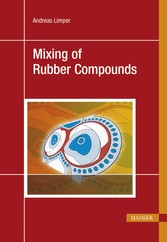Andreas Limper
Mixing of Rubber Compounds
Table of Contents
8
1 Internal Mixer – Configuration and Design
14
1.1 Machine Design
14
1.1.1 Overall Features
14
1.1.2 Mixing Chamber
15
1.2 Types of Internal Mixers
16
1.2.1 Tangential Rotors
16
1.2.2 Intermeshing Rotors
18
1.2.3 Technological Comparison
18
1.2.4 Intermeshing Rotors with Variable Clearance (VIC)
20
1.2.5 Tandem Mixing
21
1.3 Feeding Hopper
24
1.3.1 Design Considerations
24
1.3.2 Pneumatic Feeding Hopper
25
1.3.3 Hydraulic Feeding Hopper
26
1.3.4 Comparative Aspects
27
Low Noise Levels
27
Rapid Ram Movement
27
Precise Ram Force Adjustment
27
Reproducible Process Conditions
28
Reduced Operating Costs
28
1.4 Digital Ram Position Control
29
1.5 Mixing Chamber
31
1.5.1 Hard-Coating
32
1.5.2 Dust Sealing
34
1.5.3 Spring Loaded Dust Seals
35
1.5.4 Hydraulic Dust Seals with Yoke
36
1.5.5 Hydraulic Dust Seals with Cylinders (CH)
38
1.5.6 Comparison of Spring Loaded and Hydraulic Dust Seal Systems
38
1.6 Temperature Sensor
39
1.7 Plasticizer Oil Injection
42
1.8 Rotors
43
1.8.1 Assembly and Cooling
43
1.8.2 Rotor Bearings
44
1.8.3 Rotors for Tangential Internal Mixers
45
Basics
45
Two-Wing Rotors
46
Four-Wing Rotors
46
N-Rotor (Normal Rotor
also Called Standard-Rotor)47
Full-4-Wing (F-4-W)-Rotor
47
ST®-Rotor (Synchronous Technology)
48
ZZ 2-Rotor
49
HDSC-Rotor (High Dispersion Super Cooled)
50
MDSC-Rotor (Maximum Dispersion Super Cooled) [10]
51
Six-Wing Rotor [11]
51
1.8.4 Rotors for Intermeshing Internal Mixers
52
History of Development
52
Interlocking Technology
53
PES-Technology
54
1.9 Mixer Base Plate
56
1.9.1 Design
56
1.9.2 Drop Door and Latch Assembly
57
1.9.3 Drop Door and Toggle
58
References
59
2 Processing Aspects of Rubber Mixing
60
2.1 Mixing Principles
60
2.2 Process Description
63
2.3 Influence of Raw Material Properties
68
2.4 Influences of Process Parameters
70
2.5 Basic Considerations for the Development of a Mixing Cycle
79
References
81
3 Mixing Characteristics of Polymers in an Internal Mixer
84
3.1 Natural Rubber (NR)
84
3.2 Ethylene Propylene Diene Rubber (EPDM)
88
3.3 Chloroprene Rubber (CR)
91
3.4 Styrene Butadiene Rubber (SBR)
93
3.5 Butadiene Rubber (BR)
97
3.6 (Acryl)Nitrile Butadiene Rubber NBR
97
3.7 Butyl Rubber
99
3.8 Fluor Rubber
99
3.9 Resins
100
3.10 General Considerations
101
References
106
4 Internal Mixer – a Reaction Vessel
108
4.1 The Silica Network
109
4.2 Influence of Mixing Time and Temperature on Hydrophobation
110
4.3 Chemistry of the Silica-Silane Reaction
112
4.4 Temperature Limits
114
4.5 Summary and Consequences
116
References
117
5 Effect of Process Parameters on Product Properties
120
5.1 Introduction
120
5.1.2 Quality Parameters of Raw Material
121
5.1.2.1 Quality Parameters of EPDM Polymers
121
5.1.2.2 Quality Parameters of Carbon Black
122
5.2 Raw Material Changes in the Rubber Mixing Room
129
5.2.1 Increase of Carbon Black Fines Content during the Conveying Process
130
5.2.2 Baking Behavior of Carbon Black in Conveying Pipes
131
5.3 Effect of Variations in Raw Material Quality Parameters on the Mixing Process
134
5.3.1 EPDM Long Chain Branching
134
5.3.2 Carbon Black Fines Content
137
5.3.3 Carbon Black Pellet Hardness
138
5.4 Delivery Form of Sulphur
140
5.5 Weighing Accuracy
142
5.6 Predicting Product Quality
144
5.7 The Quality Assurance Concept “Future Mixing Room”
147
References for Section 5.1 to 5.7
152
5.8 Rubber Compounding and its Impact on Product Properties
154
5.9 Testing Methods for Rubber Compounds
157
5.9.1 Mooney Viscometer
158
5.9.2 Vulcameter
159
5.9.3 Rubber Process Analyzer
160
5.9.4 Carbon Black Dispersion Measurement
162
5.10 Factors Influencing Rubber Part Properties
162
5.11 The Mixing Process
164
5.11.1 The Mixing Process and its Tasks
164
5.11.2 Further Processes
166
5.12 Factors Influencing the Mixing Process
167
5.12.1 Influence of Plasticizer Addition on the Mixing Process and Compound Properties
168
5.12.2 Influences of the Mixing Process on the Injection Molding Process
170
5.12.3 Influence of the Mixing Process on Extrusion
173
5.12.4 Influence of the Milling Process on Compound and Part Properties
175
The Purpose of Roll Mills within the Mixing Process
176
The Batch-Off
180
5.13 Summary
182
References for Section 5.8 to 5.13
183
6 Dispersion and Distribution of Fillers
186
6.1 Dispersive and Distributive Mixing
187
6.1.1 Dispersive Mixing
188
6.1.2 Distributive Mixing
190
6.1.3 Quality or “Goodness” of Mixes
191
6.2 Mechanism of Filler Dispersion
192
6.2.1 Theoretical Approach
193
6.2.2 Phases of Mixing Process
194
6.2.3 Polymer-Filler versus Filler-Filler Interactions
196
6.3 Dispersion Measurements
202
6.3.1 Macro-Dispersion
203
6.3.1.1 Optical Transmission Microscopy
203
6.3.1.2 Optical Roughness Measurements
204
6.3.1.3 Mechanical Scanning Microscopy
205
6.3.1.4 Reflectometry
206
6.3.2 Micro-Dispersion
206
6.3.2.1 Electrical Measurements
206
6.3.2.2 Transmission Electron Microscopy
207
6.3.2.3 Atomic Force Microscopy
208
6.4 Control of Dispersion by Process Parameters
209
6.4.1 Mixing Procedures
209
6.4.2 Temperature, Torque, and Power Consumption
210
6.4.3 Mixing Time and Rotor Speed
211
6.4.4 Cooling
212
6.4.5 Alternative Dispersion Techniques
212
6.5 Materials Influences on Filler Dispersion
213
6.5.1 Influence of the Polymer
214
6.5.1.1 Adsorption from Solution and Melt
214
6.5.1.2 Influence of the Polymer on Filler Dispersion
216
6.5.2 Influence of the Filler Morphology and Surface Properties
218
6.5.2.1 Influence of Surface Specific Area
218
6.5.2.2 Influence of Structure
219
6.5.2.3 Influence of Filler Surface Activity
220
6.5.2.4 Dispersion Kinetics
222
6.5.2.5 Filler Re-Agglomeration
224
6.5.3 Influence of Oil on Filler Dispersion
225
6.6 Effects of Filler Dispersion on Material Behavior
226
6.6.1 Effects on Rheological Properties
226
6.6.2 Effects on Dynamical-Mechanical Properties
229
6.6.2.1 Influence of Loading
229
6.6.2.2 Strain Dependency
230
6.6.2.3 Effect of Filler Surface Modification
232
6.6.3 Effect on Ultimate Properties
232
6.7 Filler Distribution in Polymer Blends
235
6.7.1 Compatibility of Rubbers
236
6.7.2 Filler Partition
237
6.7.3 Evaluation of Filler Distribution
238
6.7.4 Distribution in Blends with Different Polymer Polarity
240
6.7.5 Filler Distribution in Blends with Similar Polarity
241
6.7.6 Filler Transfer
241
6.7.7 Effects of Filler Distribution
242
References
243
Index
250
© 2009-2024 ciando GmbH
 Zu Hanser-Fachbuch.de
Zu Hanser-Fachbuch.de
 Warenkorb
Warenkorb
